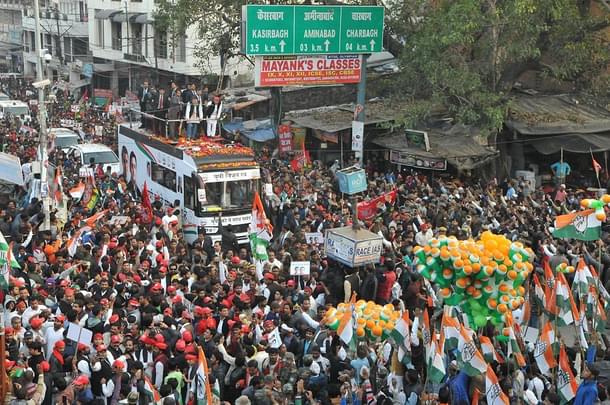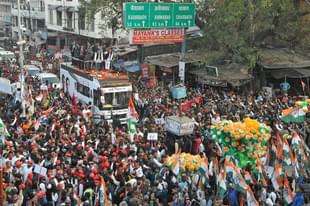Infrastructure
Why Lucknow Finds Itself In A ‘Metro Mess’, And How Other Cities Can Avoid It
Sujeet Mishra
Jun 29, 2017, 04:03 PM | Updated 04:03 PM IST
Save & read from anywhere!
Bookmark stories for easy access on any device or the Swarajya app.


The Lucknow Metro, which has been touted to be the fastest-built metro in the country, poses some interesting questions. Should every city having population above a certain metric be given a metro rail by default? Is metro rail the answer to urban mobility for every town? Is Delhi the benchmark? Did Lucknow not learn from the lessons of Jaipur which is seeing a steep fall in ridership?
Let us examine these, especially in light of the fact that several experts showcase Delhi’s Metro network and push a solution, whereby an impression of the Delhi model being the only option gets created in minds of the decision makers. If Jaipur were to be a lesson, then an immediate rethink would be needed in a host of fifty odd cities—a number mentioned in the Prime Minister’s inaugural address, while dedicating Cochi’s metro to the citizens. There is action already on the metro rail in Agra, Kanpur, Gorakhpur, Allahabad, and Varanasi.
But, first things first.
Reality check on Lucknow Metro
While certain cities are taking due care to ensure minimum inconvenience to citizens because of the diversions owing to the construction works for Metro, Lucknow clearly is not one amongst them. No alternate routes were planned, even as major arterial routes were closed by the authorities in a bid to get the construction work going. This left the citizens harried.
Lucknow’s north-south corridor originates from the airport and runs through the main railway station at Charbagh before it goes through the city. As work on the Lucknow Metro took off at record breaking pace (contractors love doing this as they can have quicker turnaround of capital, technically a win-win situation), the route shown in red in figure one, was taken off the bounds of vehicular traffic.

The route which gives connectivity to the Charbagh railway station and the main bus terminal was suddenly taken off the road grid, barring a trickle.
(A word about the Charbagh station here. It is actually a complex one with two different railway stations, of which one is run by the Northern and the other by the North Eastern Railway).
Shown in black on the map is the alternate route which runs through the cantonment. Suddenly, this route had to bear the brunt of the unwarily diverted traffic. Though the situation eased, its ripple effect continues to be felt.
Diversions were given through areas which never could take so much of traffic. Shown in the map are the existing trouble spots which just got exponentially compounded with the onset of construction.
As traffic in Lucknow picked up over the years, the city, for want of integrated urban mobility planning, was slowly sapped of its resilience to handle disruptions. As seen in the map, the metro line originates from Amausi, the airport area. This line is being constructed on the Lucknow-Kanpur highway. This route always takes heavy traffic and in the absence of a proper ring road, heavy vehicles (including the stream of long trailers carrying cars from factories in Uttarakhand) also partly ply on this.
In such a situation, when the Uttar Pradesh elections neared, there were legendary traffic snarls, when there were protests by numerous unions and associations. With the main arterial link unavailable, the alternative routes saw load beyond what they could handle. And the existence of a VVIP guest house, the Chief Minister’s residence, the then ruling party’s office and a major school only added to the traffic woes, with journey times shooting multi-fold on several days.
As construction extends to a major intersection called the Polytechnic Crossing, confusion seems to be mounting on the major arterial link road to the industrial area, college complexes, the High Court, as well as to Faizabad and Gorakhpur. Additionally, even as the Polytechnic crossing links the Faizabad and the Ring Roads, the flyover meant to bypass this crossing is lying broken since the past one year and only one carriageway is available on the same.
Is Lucknow a New Delhi, or for that matter are Allahabad, Kanpur, Gorakhpur comparable to New Delhi?
After putting the city through such avoidable pain, would the Metro achieve its stated objectives? Could more nimble solutions be tried before?
A conventional metro rail network uses very heavy civil infrastructure. This eats up valuable space on the already crowded roads impacting fluidity of traffic flows. Moreover, metro rail networks have to be designed for maximum possible loads on day one and cannot be realigned ever.
The Jaipur Metro possibly started on similar premises and was expeditiously built and put to operation. Its falling ridership should be a loud wakeup call. Solutions like trams without overhead lines are very compelling solutions for several of the cities. Metro rail in cities like Delhi, Mumbai, Kolkata, Bengaluru, Chennai make sense due to the large passenger-kilometre figures wherein both the number of passengers and the distance travelled are high. A metric called PHPDT-’per hour per direction traffic’ is a useful measure which captures the mass of people which needs to be moved in a particular direction.
The number of people travelling between Delhi and Gurgaon is almost equal to the population of a small city; and the same can be said about the number travelling from Noida, Ghaziabad and Faridabad. Even when the Delhi Metro Rail Corporation (DMRC) was born, Delhi had more vehicles than Mumbai, Kolkata and Chennai combined. New Delhi, hemmed by Meerut, Ghaziabad, Noida, Faridabad and Gurgaon, presented a geographical spread which could have been rapidly transited only through a dedicated right of way. Further, the sheer number of people who commuted the region could be counted on for ridership. Well planned corridors meant good ridership, making DMRC one of the few metro rail systems in the world making operational profits.
Cities like Lucknow which have low industrialisation and a small spread have very different needs. Also, cities like Kanpur, Varanasi. Allahabad, Agra have very few arterial links. In such a situation, can these be compared to New Delhi? Hardly.
Jaipur, despite being a capital city with a high tourist flow, and definitely more industrialised than Lucknow, has seen ridership figures nose dive. One can argue that the Jaipur metro is still in infancy, but this argument will hardly hold. Enormous amounts which have to be committed upfront leaves heavy debt load on posterity. Cities like New Delhi earn sufficiently to justify a perpetual subsidised network for the role the metro network plays in the city’s economy. However, for cities like Cochin, Jaipur, Lucknow, this subsidy would sap the much needed revenues required to support the population.
Fundamental troubling issues
Walk to a pillar of a metro system and take a look. Can there ever be a possibility of rethinking the alignment? Also, a metro structure is simply very heavy, pushing cost per kilometre to well over Rs 200 crore. Also, though the metro rail offers multi-modal exchange, it can inherently not provide first and last mile connectivity.
Enter Bus Rapid Transit (BRT)
The bus based mass-rapid-transit earned a very bad name in New Delhi where its dismantling became an election issue. This hides highly successful examples from Ahmedabad, Surat, Hubli-Dharwad, Pune and Indore. A study comparing the BRT corridor of Ahmedabad and Delhi Metro brought forth a startling fact-Ahmedabad’s solution was almost 40 times cheaper!
Further, BRTs have much lower capital expenditure for civil structures, and realignment is a possibility. Use of electric buses (battery operated or trolley or mix of both) can take care of pollution fears. Half the cost of the Ahmedabad BRT was funded by the local body. Imagine the possibilities thus, when a solution can be largely handled at the local level, can be realigned and augmented, and the vehicles can be upgraded with small incremental efforts.
Why did BRTs fail to find traction?
Buses, synonymous of state transport services, represented everything which is considered broken in public space—failing on metrics of reliability, punctuality, safety and ease of use. Costs as low as Rs 10-20 crore per km is something which does not interest big banking institutions. Whereas ‘Rs 250 crore per km’ brings serious money on the table for scores of consultants and big orders for large system suppliers (civil, electrical, signalling, and communication and rolling stock).
Moreover, when it comes to BRT corridor evaluation, evaluators become unforgiving, not extending options of elevated corridors, dedicated depots etc. In short, not according a BRT the same respect and mental space as a metro rail.
Breakthroughs in technology like platooning with good backend support can even make bus-based mass rapid solutions greatly bridge the first and the last mile gaps.
But, why would consultants like to promote a much cheaper option? That there is distinct conflict of interest in the way the metro rail is being pushed as the only solution needs to be looked into.
Need for integrated planning
The DMRC stands towering, with a reputation of impeccable project execution. It has been the only organisation which has experienced construction of a metro rail system in a brownfield city. However, continued reliance on DMRC to make project reports prevents governments from examining the alternatives. There is a tendency of replicating the DMRC model even where there can be other viable options. Being a symbol of growth and progress, it is considered politically rewarding to deliver a mega buck project like the Metro Railway. For sure, Lucknow Metro was one of the flagship vikas karya showcased by the previous UP government.
Traffic studies should be done by experts with a strong local anchor. Mobility flows need to be looked at just the way one would look at a drainage system. You cannot construct a trunk drain and leave it at that, small streams need to be constructed which then drain in and drain out this trunk. Sadly, capital expenditure heavy metro rails would hardly leave any fiscal breathing space to bring in these streams.
Before considering the metro rail option, a city needs to consider investing in a system of ring railways, ring roads and radials, and consider the modern bus-based transit system. State governments have to evaluate and check if massive metro rail construction at the current costs would leave them with meaningful funds after servicing the loans.
The DMRC stands tall with sovereign backed loans. Delhi’s services and manufacturing sector is big enough to perpetually pay for the expenses which are way above the operating costs. The same can not be held true for cities like Lucknow, Kanpur, Gorakhpur, Allahabad, Varanasi, Bhopal and others.
Dr Sujeet Mishra is a railwayman and currently the OSD of the National Rail and Transportation Institute, which is in transition to become Gati Shakti Vishwavidyala, a central university.





